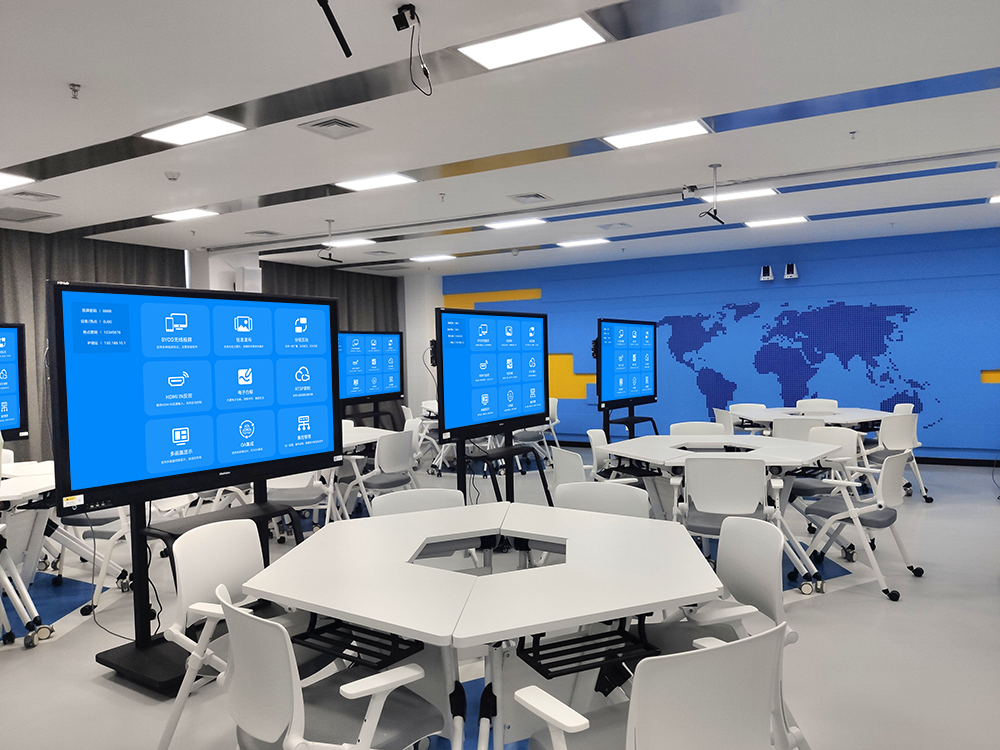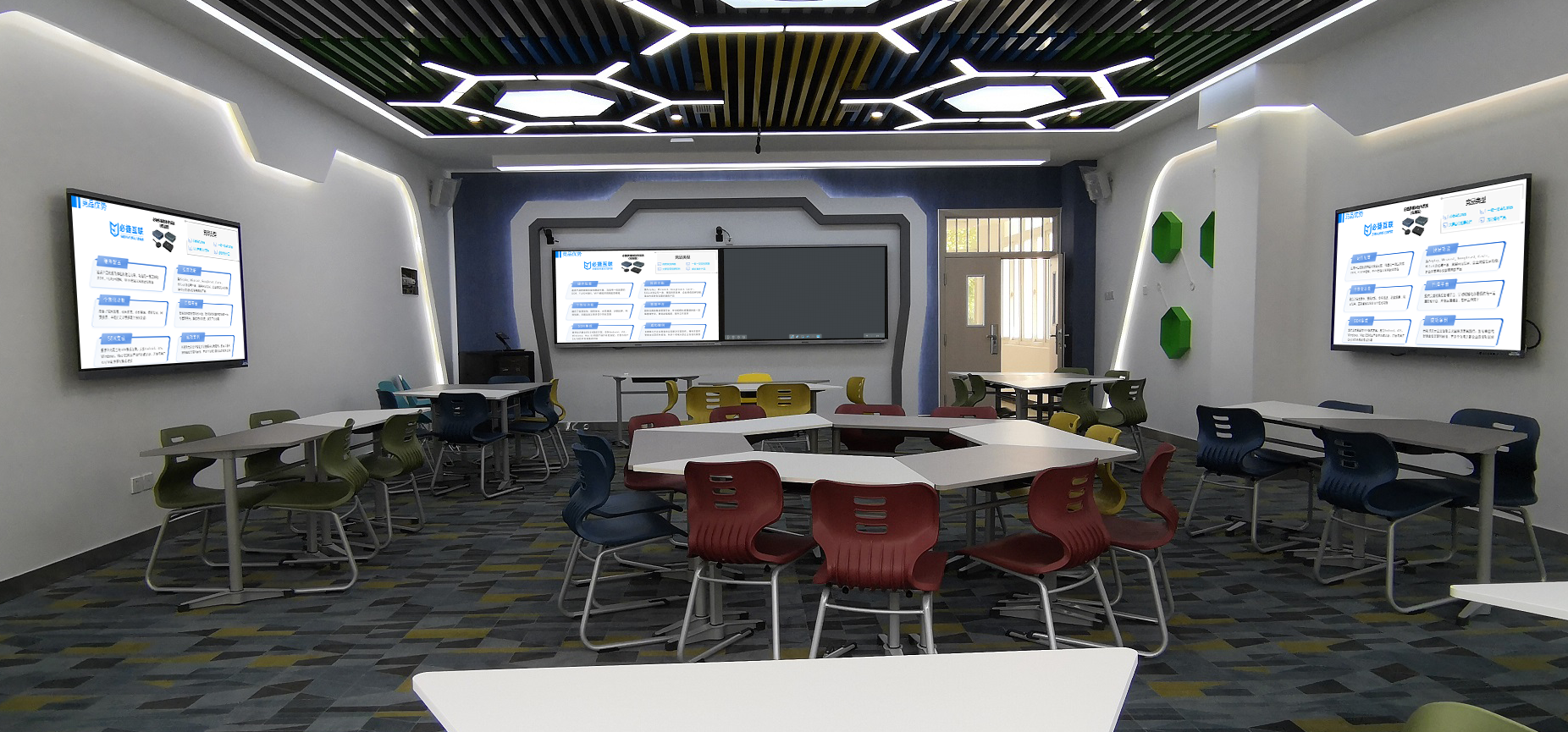Smart Classrooms: An Intelligent Space Solution for Empowering Educational Innovation
The smart classroom solution is centered on “technology integrating with education.” It integrates technologies such as the Internet of Things, artificial intelligence, and wireless interconnection to build a modern teaching space that combines “interactive teaching, resource sharing, data-driven insights, and smart management.” This helps teachers achieve precision teaching, motivates students to learn actively, and transforms the classroom from traditional instruction to in-depth interaction.
Core Device Architecture
- Smart Interactive Main Screen: It is equipped with an 86-inch 4K touch-sensitive smart blackboard that supports ten-point touch and anti-glare technology. You can directly write, erase, and zoom with your hands. It has a built-in Bijie proprietary screen mirroring module that is compatible with all protocols like AirPlay and Miracast. Teachers can mirror content from their phones, computers, and tablets with one click, with a latency as low as 20ms, ensuring that courseware is displayed clearly and smoothly.
- Group Collaboration Terminals: It is configured with 21.5-inch touch screens for groups of 6-8 people. It supports wireless screen mirroring and real-time annotation within a group. Members can use a stylus to draw mind maps and annotate key content, and the discussion results can be “pushed” to the main screen for all to see, facilitating class-wide communication.
- Learning Information Collection System: Equipped with an AI camera and a microphone array, it uses facial recognition for student attendance and automatically analyzes classroom focus. The microphone supports a pickup range of 5 meters and sound source localization, accurately capturing student speeches and ensuring clear and smooth remote interaction.
- Environmental Control System: It links to devices like lights, curtains, and air conditioners to automatically adjust based on the teaching scenario. When projecting, it automatically dims the lights. In summer classes, it keeps the temperature stable at 24°C, creating a comfortable environment for teachers and students.
Key Teaching Functions
- All-Scenario Interactive Teaching: A teacher can launch interactive quizzes with multiple-choice, subjective questions, etc., from the main screen. Students submit their answers using a tablet or an answer pad, and a data dashboard is generated on the main screen in 3 seconds, showing accuracy rates and the distribution of incorrect options at a glance. For frequently missed questions, the system automatically pushes similar examples, enabling “practice on the spot” and increasing teaching relevance by 60%.
- Multi-Screen Collaborative Annotation: When a teacher annotates key points of courseware on the main screen, the content is synchronized in real time to all student terminals. Students can add question marks on their tablets, and the teacher’s terminal receives them in real time and prioritizes the explanation. During group discussions, the annotated mind maps from each group are compared in a split-screen view on the main screen, and the collision of different ideas stimulates innovative thinking.
- Virtual-Real Integration Teaching: It integrates an AR mirroring function. A teacher can scan a textbook with a tablet to trigger a 3D model, such as a three-dimensional circuit diagram in a physics class or a cell structure in a biology class. It supports 360° rotation and dissection demonstrations, increasing the tangibility of abstract knowledge by 50% and significantly improving student comprehension efficiency.
- Intelligent Resource Push: Based on the Bijie Education Cloud Platform, it builds a school-based resource library categorized by “subject – grade level – knowledge point.” Teachers can call up resources like courseware, micro-lectures, and practice questions with one click and mirror them for display. Based on student answer data, the system automatically pushes personalized learning materials. For example, a student weak in the “functions” module of mathematics will receive targeted instructional videos and practice questions.

Scenario-Based Teaching Applications
(I) Theoretical Classroom Teaching
- Precision Instruction: After a teacher mirrors courseware, they can use a stylus on the main screen to derive a mathematical formula or annotate a passage in a Chinese text. Key content is automatically synchronized to student tablets for easy review after class. The Bijie teaching software can be used to launch a classroom quiz, and the main screen displays the students’ progress in real time. If the error rate for a knowledge point exceeds 70%, the teacher can immediately pause the lecture and re-explain it with examples to ensure students understand and learn.
- Debate-Style Learning: The class is divided into pro and con sides to discuss “the pros and cons of technological development.” Both sides mirror their arguments from their group terminals, and the main screen displays a split-screen view of their argument trees. The AI assistant captures keyword frequencies in real time, generating a logical correlation graph that helps students sort out their line of reasoning and effectively cultivates critical thinking.
(II) Experimental Inquiry Teaching
- Microscopic Experiment Display: By connecting a microscope via a Bijie HD acquisition box, microscopic footage of cell division or bacterial observation can be mirrored to the main screen, which supports 4K magnification and frame rate adjustment, allowing all students to clearly observe the details. A teacher can use a stylus to annotate the names of cell structures, and students can do the same on their tablets to deepen their memory of the knowledge points.
- Virtual Simulation Operation: For dangerous experiments like chemical explosions or high-voltage electricity, VR mirroring technology is used. Students wear lightweight VR glasses to perform the operations, and the main screen simultaneously displays the operation footage and a step-by-step score. Incorrect operations trigger a safety warning, which ensures teaching effectiveness while avoiding safety risks.
(III) Cross-School Collaborative Teaching
- Synchronized Classrooms: The main screen content of a high-quality urban teacher is synchronized in real time to a rural classroom. Students from both locations can use interactive tablets to answer questions and ask questions. The rural students’ answer data is fed back to the main lecturer in real time, allowing them to “be in the same class.” The Bijie Cloud Platform ensures an audio/video latency of ≤300ms, making remote interaction feel like an in-person discussion.
- Collaborative Research Projects: Students from different schools team up to complete a project on “local ecological environment investigation.” They share on-site investigation videos and data analysis charts via cross-school mirroring and work together to draw an ecological protection plan on the main screen, cultivating teamwork and research skills.
Management and O&M System
- Smart Academic Management: The Bijie Academic Platform supports functions such as course reservations, device scheduling, and attendance statistics. Teachers can reserve classrooms and equipment online, and the system automatically matches the resources. Student attendance data is automatically synchronized to the school’s academic system, reducing the workload of manual statistics.
- Remote Device Maintenance: Administrators can use the Bijie cloud backend to monitor the real-time operational status of classroom devices, including projector lamp life, interactive screen touch accuracy, and network bandwidth. The system automatically sends alarms for abnormal status. The remote troubleshooting rate is 85%, and on-site maintenance costs are reduced by 60%.
- Data Security Assurance: Class recordings and student data are stored locally with encryption, and only authorized teachers can view them. Mirrored content transmission uses AES-256 encryption to prevent information leakage, which complies with educational industry data security standards.
The core of the smart classroom solution is to make technology serve the essence of education. By using device interconnection to break down interactive barriers, data-driven insights to achieve precision teaching, and resource sharing to broaden the boundaries of learning, it frees teachers from cumbersome operations to focus on teaching design. It transforms students from passive recipients to active participants, making them the true masters of their learning, and ultimately achieves a dual improvement in teaching quality and learning efficiency.